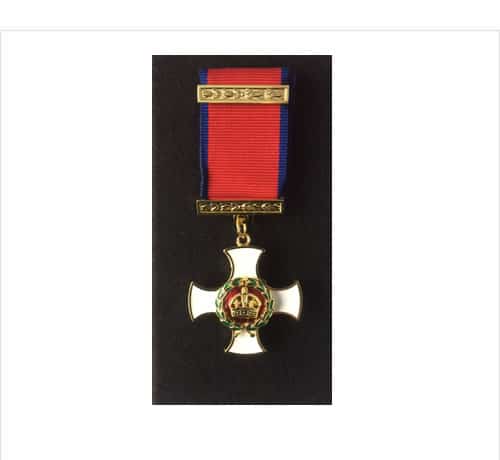“For services during operations in South Africa”.
The services were as follows: On 1 April 1902, near Springs, South Africa, when acting as Intelligence Officer to a Column, he led the Queen’s Bays to capture some Boers on a deserted farm. After capturing some prisoners, this regiment was attacked at dawn by superior numbers and fought a rear-guard action until the 7th Hussars came up and counterattacked the enemy.
Major Vaughan commanded one wing of the Bays during the retirement, after having been wounded before daylight, and subsequently advanced with a squadron of the 7th Hussars to assist them with his knowledge of the country. He continued fighting till he fainted.
Sir A. Conan Doyle says on pages 522-623 of ‘The Great Boer War’:
“One of the consequences of the successful drives about to be described in the Orange River Colony was that a number of the Free Staters came north of the Vaal in order to get away from the extreme pressure upon the south.
At the end of March, a considerable number had reinforced the local commandos in that district to the east of Springs, no very great distance from Johannesburg, which had always been a storm centre. A cavalry force was stationed at this spot which consisted at that time of the 2nd Queen’s Bays, the 7th Hussars, and some National Scouts, all under Colonel Lawley of the Hussars.
After a series of minor engagements east of Springs, Lawley had possessed himself of Boschman’s Kop, eighteen miles from that town, close to the district which was the chief scene of Boer activity. From this base, he dispatched upon the morning of 1 April three squadrons of the Bays under Colonel Fanshawe, for the purpose of surprising a small force of the enemy which was reported at one of the farms. Fanshawe’s strength was about three hundred men.
The British cavalry found themselves, however, in the position of the hunter who, when he is out for a snipe, puts up a tiger. All went well with the expedition as far as Holspruit, the farm which they had started to search. Commandant Pretorius, to whom it belonged, was taken by the energy of Major Vaughan, who pursued and overtook his Cape cart. It was found, however, that Alberts’s commando was camped at the farm, and that the Bays were in the presence of a very superior force of the enemy.
The night was dark, and when the firing began it was almost muzzle to muzzle, with the greatest possible difficulty in telling friend from foe. The three squadrons fell back upon some rising ground, keeping admirable order under the most difficult circumstances.
In spite of the darkness the attack was pressed fiercely home, and with their favourite tactics the burghers rapidly outflanked the position taken up by the cavalry.
The British moved by alternate squadrons onto a higher rocky kopje on the east, which could be vaguely distinguished looming in the darkness against the skyline. ‘B’ Squadron, the last to retire, was actually charged and ridden through by the brave assailants, firing from their saddles as they broke through the ranks. The British had hardly time to reach the kopje and to dismount and line its edge when the Boers, yelling loudly, charged with their horses up the steep flanks. Twice they were beaten back, but the third time they seized one corner of the hill and opened a hot fire upon the rear of the line of men who were defending the other side.
Dawn was now breaking, and the situation most serious, for the Boers were in very superior numbers and were pushing their pursuit with the utmost vigour and determination. A small party of officers and men whose horses had been shot covered the retreat of their comrades, and continued to fire until all of them, two officers and twenty-three men, were killed or wounded, the whole of their desperate defence being conducted within from thirty to fifty yards of the enemy.
The remainder of the regiment was now retired to successive ridges, each of which was rapidly outflanked by the Boers, whose whole method of conducting their attack was extraordinarily skilful. Nothing but the excellent discipline of the overmatched troopers prevented the retreat from becoming a rout. Fortunately, before the pressure became intolerable, the 7th Hussars with some artillery came to the rescue and turned the tide.
The Hussars galloped in with such dash that some of them actually got among the Boers with their swords, but the enemy rapidly fell back and disappeared.
In this very sharp and sanguinary cavalry skirmish, the Bays lost eighty killed and wounded out of a total force of 270. To stand such losses under such circumstances, and to preserve absolute discipline and order, is a fine test of soldierly virtue.
The adjutant, the squadron leaders, and six out of ten officers were killed or wounded. The Boers lost equally heavily. Two Prinsloos, one of them a commandant, and three field cornets were among the slain, with seventy other casualties. The force under General Alberts was a considerable one, not fewer than six hundred rifles so the action at Holspruit is one which adds another name of honour to the battle-roll of the Bays.
It is pleasing to add that in this and the other actions which were fought at the end of the war our wounded met with kindness and consideration from the enemy”.


